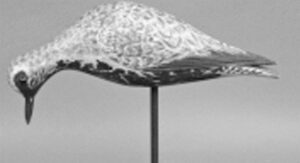 By Rosemary McKittrick
By Rosemary McKittrick Humans are more easily fooled by decoys than birds are. That’s the old joke among decoy collectors. The work of master carver Elmer Crowell (1862-1951) just might be the exception. His work is housed in the collection of the Shelburne Museum.
Some say Crowell was the best carver ever. Maybe it was his passion for hunting. Maybe it was purely instinctive.
Whatever the reason, Crowell carved decoys that were so true to life they seemed like they were breathing. He was a master not only of carving and paint but also shading. He captured the subtleties. Prolific, versatile and consistent, that was Elmer Crowell.
As a young man he worked as a market gunner and cranberry farmer in Cape Cod, Mass. He carved a few decoys early on but when he hunted himself he preferred using live decoys. That is, tame birds tethered so they fool their wild relatives.
Life changed for Crowell in 1900. He went to work for Dr. John C. Phillips, a wealthy Boston physician, managing his hunting camp at Wenham Lake, north of Boston. Crowell worked for Phillips for almost ten years. During that time he sold a number of amazing one-of-a kind decoys and decorative carvings to Phillips and his friends.
He began carving decoys full-time in 1912 with miniature song and shorebirds. Crowell worked in a small shop outside his home in East Harwich, Mass. With help from his son Cleon (1891-1961), he also carved decorative pieces and miniatures.
Rheumatism forced his retirement in 1943.
Decoys may have started out as utilitarian objects but they’ve ended up as works of art. Just ask collectors. Decoys have also been around a lot longer than you might expect.
In 1924 archeologists unearthed 11 ancient working decoys that were 1,000 years old, in the Humboldt Range of western Nevada. Native Americans made decoys by weaving reeds into the shape of a duck and also by mounting the feathery bird skin onto a frame.
Even though wild fowl have been hunted all over the world since prehistoric times, it appears the Native Americans were the first to use artificial decoys to lure birds.
In terms of value, excellent condition with no repairs or restoration is the most desirable. Condition of the paint is one of the most reliable guides to the age and worth of a decoy.
Old decoys were often given a new coat of paint every so often. Therefore, many layers of cracked paint suggest a vintage decoy. Collectors are also rarely interested in repainting old decoys. The original paint even when it’s scratched and faded is the best.
Identifying decoy carvers is also difficult because carvers rarely signed their decoys. Crowell helpfully stamped his oval brand on the base of his work. In fact, names stamped on old decoys may well turn out to be the decoy’s owner, not the maker.















Follow Us